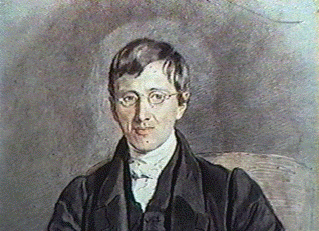 John Henry Newman began his career as an Anglican
churchman and scholar and ended it as a Roman
Catholic cardinal. He was born in London on February 21, 1801, and
at the age of fifteen, he enrolled in Trinity College, beginning an association
with Oxford University that would last for nearly thirty years.
John Henry Newman began his career as an Anglican
churchman and scholar and ended it as a Roman
Catholic cardinal. He was born in London on February 21, 1801, and
at the age of fifteen, he enrolled in Trinity College, beginning an association
with Oxford University that would last for nearly thirty years.
Newman moved from Trinity to Oriel College after receiving his bachelor's degree in 1820, becoming a fellow in 1822 and a tutor in 1826. Two years later, Edward Hawkins became the new provost of Oriel. Newman supported Hawkins' candidacy, but it soon became clear that the two held different views about the responsibilities of a college tutor: Newman believed that the tutorship carried some pastoral duties, while Hawkins maintained that the tutor/student relationship should be strictly academic. When Newman objected to this view, Hawkins cut off his supply of new students, leaving him little choice but to resign his post, which he did in 1832.
Newman's work in Oxford did not end with his resignation from the Oriel tutorship. He had held academic and pastoral assignments simultaneously for several years, serving first as both fellow of Oriel and curate of St. Clement's and later as both tutor and vicar of St. Mary's. He remained in his pastoral office until 1843, attracting hundreds of students, university officials, and townspeople to St. Mary's [this church's UK site] with his scholarly yet earnest preaching.
The high point of Newman's Anglican career was his influential role in the Oxford Movement, a High Church effort to return to the foundations of the faith--the sacraments, episcopal governance, and apostolic succession--and to affirm the Church's status as the via media, the middle ground between Roman Catholicism's unfounded claims to authority and infallibility and the Dissenters' equally unfounded emphasis upon spiritual liberty and private judgment. The Movement began on July 14, 1833, when John Keble delivered a sermon entitled "National Apostasy" (full text)from the pulpit of St. Mary's. Newman became involved a few months later and was the Movement's primary spokesman, promoting its doctrinal and moral concerns through his editorship of the British Critic, his contributions to Tracts for the Times, and his weekly sermons at St. Mary's.
In 1839, Newman began to lose confidence in the cause. The study of the Monophysites he undertook that summer raised doubts about the validity of the via media, and he soon became convinced that Rome, not Canterbury, was the home of the true Church. He expressed his new views in Tract Ninety, in which he argued that the Thirty-Nine Articles, the doctrinal statement of the Church of England, could be interpreted in a way that supported Roman Catholic doctrine. The Tract was published on February 27, 1841; its censure by the Oxford authorities on March 15 was a severe blow to the Movement and led to Newman's rapid withdrawal from Anglican life. Between July 1841 and September 1843, he left the British Critic, moved from Oxford to a semi-monastic community at Littlemore, retracted the anti-Catholic statements he had published, and resigned his position at St. Mary's.
Two years after leaving St. Mary's, Newman began a new life as a Roman Catholic. He was officially received into the Church on October 9, 1845 and was ordained to the priesthood the next year. His work with the Church included establishing the Oratory of St. Philip Neri near Birmingham in 1848 and helping to create the Catholic University of Ireland, which he served as rector from 1854 to 1858. He continued to write as well; some of the major publications of his Catholic years were Parochial and Plain Sermons (1868), a new edition of his Anglican discourses; The Idea of University (1852), a collection of the inaugural lectures for the Catholic University and other academic essays; An Essay in Aid of a Grammar of Assent (1870), a treatise on the philosophy of religion; and Apologia Pro Vita Sua (1864), his classic work of spiritual autobiography.
The 1870s brought Newman special recognition for his work as both an Anglican and a Roman Catholic. In 1877 he became the first person elected to an honorary fellowship of Trinity College; two years later, Pope Leo XIII awarded him a place in the College of Cardinals. He died on August 11, 1890, and was buried in Warwickshire. His epitaph reads, "Ex umbris et imaginibus in veritatem"--"out of shadows and pictures into truth."
Last modified 9 June 1996